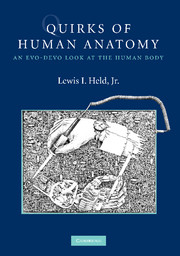Book contents
- Frontmatter
- Contents
- Preface
- CHAPTER 1 BACKGROUND
- CHAPTER 2 SYMMETRY AND ASYMMETRY
- CHAPTER 3 MYSTERIES OF THE MIDLINE
- CHAPTER 4 MERISM AND MODULARITY
- CHAPTER 5 SEXUAL DIMORPHISMS
- CHAPTER 6 SILLY, STUPID, AND DANGEROUS QUIRKS
- CHAPTER 7 MIND AND BRAIN
- EPILOGUE
- APPENDIX: QUIRKS OF HUMAN BEHAVIOR
- References
- Index
CHAPTER 6 - SILLY, STUPID, AND DANGEROUS QUIRKS
Published online by Cambridge University Press: 05 August 2012
- Frontmatter
- Contents
- Preface
- CHAPTER 1 BACKGROUND
- CHAPTER 2 SYMMETRY AND ASYMMETRY
- CHAPTER 3 MYSTERIES OF THE MIDLINE
- CHAPTER 4 MERISM AND MODULARITY
- CHAPTER 5 SEXUAL DIMORPHISMS
- CHAPTER 6 SILLY, STUPID, AND DANGEROUS QUIRKS
- CHAPTER 7 MIND AND BRAIN
- EPILOGUE
- APPENDIX: QUIRKS OF HUMAN BEHAVIOR
- References
- Index
Summary
Anyone who thinks that our body is a marvel of mechanical engineering should get out a phone book and scan the listings of orthodontists, orthopedists, optometrists, and chiropractors-to name just a few specialties. Those doctors are making good livings treating our sundry flaws. Face it: our body has many features that could work much better. The sad fact is that evolution is no engineer [2657]. It's just a tinkerer [1265, 1266].
Worse than that, evolution is a myopic tinkerer. It can only solve immediate problems using available variations [226]. If its spur-of-the-moment contrivances turn out to be liabilities at a later date under different circumstances, well, that's just tough luck! Adaptations are typically quite hard to undo. In this way some of our organs have gotten themselves into predicaments akin to people in a bad marriage, who often mutter to themselves, “But it seemed like a good idea at the time!” Indeed, this familiar phrase offers a convenient shorthand for denoting the phenomenon:
bislagiatt /bis-‘la-gi-,att/adj [acronym: but it seemed like a good idea at the time!]: suboptimal functioning of a structure due to (1) its being used in a novel context (e.g., a bipedal vs. quadrupedal stance) and (2) the inability of evolution to fix it (e.g., due to prohibitive demands of genomic rewiring). Tantamount to a species getting stuck on a low peak in a rugged adaptive landscape [593].
A small sample of our shortcomings is sketched in Figure 6.1, and a larger batch is inventoried in Table 6.1. Other authors have discussed some of them [1103, 2384, 2824].
- Type
- Chapter
- Information
- Quirks of Human AnatomyAn Evo-Devo Look at the Human Body, pp. 105 - 130Publisher: Cambridge University PressPrint publication year: 2009



